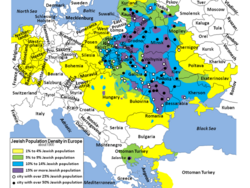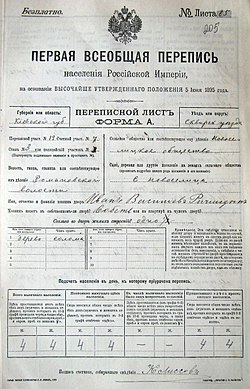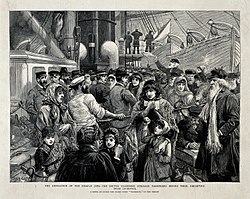
Genealogy has always been an important topic within Jewish tradition and has played a part in the lives of Jews from ancient times to the present. The Torah contains many references to genealogy. Despite the migrations of the Jews, genealogy is connected with “the long-cherished traditions associated with the Jewish Home”[1], so the families of Polish-Lithuanian Jewish aristocracy, being mostly of rabbinical origin preserved their ancestors’ family lines, some of them dating back to the Middle Ages, such as:
However, most of the Jewish families that became subjects of the Russian Empire after the annexation of Poland in the 18th century were very poor and not educated, so they didn’t conduct any family records. At this moment, the Russian Empire, with 900,000 "new" Jews, hosted the largest Jewish population in the world.
Until the breakup of the Soviet Union in 1991, Jewish civil records in the former Russian Empire, including Ukraine, were virtually inaccessible. Yet obtaining a record from the Russian archives meant physical presence in the archive and searching through thousands of census records and metrical books. During the past few decades, the archives were digitized and became available online through different genealogy databases. The availability of records is still very limited: many of them didn’t survive the pogroms, wars, Holocaust, and Soviet censorship, and a lot of vital records didn’t exist at all.
Research your ancestors on MyHeritage
Sources for Russian Jewish genealogy researchSources for Russian Jewish genealogy research

St. Petersburg houses the largest historical archive in Russia. This archive is called the Russian State Historical Archive (RGIA)[2] and contains around seven million items, including tax records and draft lists, related to the prerevolutionary period, which is the period from the early 18th century to 1917.[3]
The first Russian Empire population census was conducted in 1897 and was the first registration act, which was used for statistical purposes only. It includes 13,465 Jewish individuals (2,475 families).
Another reliable resource is regional local archives, libraries, and museums. Many of these archives didn’t survive the time and historical cataclysms, though.
Military archives include data about everyone who was in the army service. The shortcoming of this source is that it’s hard to trace an individual if the dates of service are unknown.
Searching through online databasescould be advantageous in discovering information that has already been uncovered by others.
Challenges of Russian Jewish genealogy researchChallenges of Russian Jewish genealogy research

Jewish genealogy is a complex endeavor due to the scarcity of information available on Jewish ancestors. In most cases, individuals of Jewish descent do not have well-documented family trees that can provide detailed information about their ancestry, even going back several generations. This issue is particularly acute for those who do not come from families of rabbinical descent. The primary cause of this lack of information is the absence of family trees and other paper trails, which can make it challenging to trace one's family history beyond a certain point.[4]
Most Ashkenazi Jews did not have surnames until the early 1800s. The vast majority of the two million Jews in the Russian Empire’s Pale of Settlement did not have surnames until 1804. Since Jews were listed in all censuses without surnames prior to 1804, it’s almost impossible to trace Jewish ancestors prior to this moment.
When in 1827 the Jews became liable to conscription, families tried to avoid the draft in any possible way: they registered the boys as belonging to other families, and hid them from the census takers. These tricks resulted in the creation of many thousands of new surnames for related people while simultaneously resulting in many non-related people having the same surname.
Records and archives' destructionRecords and archives' destruction
In the former Russian Empire, only a fraction of Jewish vital records and censuses have survived, and their availability varies widely from region to region. Undoubtedly, the widespread destruction of Jewish homes, businesses, and synagogues that took place during the numerous pogroms that swept through the Russian Pale of Settlement during the late 19th and early 20th centuries, in combination with virulent anti-Semitism in Russia and Ukraine both before and after World War II, is responsible for much of this destruction.
LanguagesLanguages
Many records from the Russian Empire, even if digitized, remain untranslated into English. Official European civil records such as censuses were written in the language of the country, while vital records (birth, marriage, death, and divorce registrations) were maintained by different religious clergy and recorded in their respective languages. Jewish records were in Hebrew. The records in the Russian Empire used an old form of Cyrillic script that is handwritten and in cursive. Another difficulty is that Russian civil authorities could hardly speak or understand Yiddish, so mistakes, such as the incorrect spelling of surnames, parents’ names, or town names, could easily occur in the censuses or vital records.
Place of residencePlace of residence
Individuals from small towns or shtetls might have listed the name of the nearest large town, province, or even the country of Russia. Additionally, people often moved from one town to another within a region or to other regions altogether, making it challenging to determine their exact place of origin.
Another complicating factor is the way in which censuses (known as revision lists) were conducted in the Russian Empire. Individuals were not necessarily included in a census based on the community in which they lived at the time of the census. Instead, they were included on the census for the community to which they originally belonged. These factors can create challenges for Jewish genealogists trying to trace their ancestors' origins and movements.
EndogamyEndogamy
Endogamy refers to the custom of marrying within the same cultural, ethnic, social, or religious group. In an endogamous population, everyone is related to each other in a recent genealogical timeframe on multiple ancestral pathways since they all descend from the same small gene pool. Ashkenazi Jews are one of many known endogamous populations. The endogamy among Ashkenazi Jews was both internally mandated through religious and cultural tenets and externally imposed through laws that prohibited marriage to non-Jews. Severe restrictions were also placed upon Jewish movements, places of residence, and marriage rights within small shtetls in Eastern Europe and the Russian Pale of Settlement.
Explore more about Russian Jewish genealogyExplore more about Russian Jewish genealogy
- Family History Search at MyHeritage.com
- How to Research Your Ethnicity with Genealogy on the MyHeritage Genealogy Hub
- Can the MyHeritage DNA test prove Jewish ancestry? on the MyHeritage Help Center
- How to Research Your Jewish Ancestors on MyHeritage at MyHeritage Knowledge Base
- Holocaust Database at JewishGen
- Russian State Historical Archive at Russian State Historical Archive (RGIA) (in RU)
ReferencesReferences
- ↑ Glenn Dynner: Men of Silk: The Hasidic Conquest of Polish Jewish Society. Oxford University Press, 2008
- ↑ https://fgurgia.ru/
- ↑ https://feefhs.org/resource/russia-blitz-jewish
- ↑ Paull, Jeffrey Mark. "Why Is Jewish Genealogy So Challenging?." 2020.

